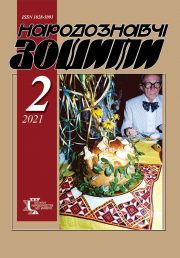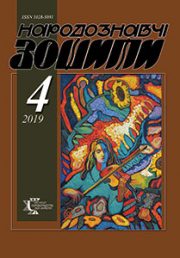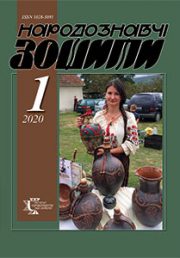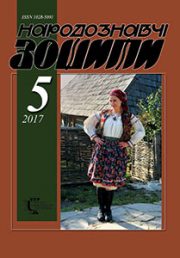The Ethnology Notebooks. 2021. № 3 (159), 666—674
UDK [39:069:745/749.011.26](=161.2):930.2
DOI https://doi.org/10.15407/nz2021.03.666
THE SIGNIFICANCE OF ART AND CRAFT MONUMENTS IN UKRAINIAN CULTURAL HERITAGE
BOLYUK Oleh
- ORCID ID: https://orcid.org/0000-0002-8292-202X
- Candidate of History Arts (Ph. D),
- Researcher at Folk Art Department
- of Ethnology Institute of the NAS of Ukraine
- 15, Svoboda ave., 79000, Lviv, Ukraine
- Contacts: e-mail: oleh.bolyuk@gmail.com
Abstract. The urgency of the research topic is due to the lack of clear legal documents and guidelines of determination and pointing in relation to the account of traditional works of decorative and applied arts.
The purpose of the work is to propose a concept that indicates the specific place of monuments of decorative and applied arts in the system of cultural heritage. The object of research is the legal documents in Ukraine, which reflect the legal framework of cultural heritage. The subject of research is the terminological apparatus of cultural heritage. The methodological basis of the study is hermeneutics and analytical method, information, system and axiological approaches and terminological principle.
Cultural heritage is a permanent process, based on the tradition of creativity and ability to accumulate current trends of social development. Some sources of documentary documentation on heritage protection were studied. The definition of monuments of the Ukrainians’ traditional folk decorative and applied art indicates their place in the cultural heritage, which are not divided into «material» and «non-material».
The sources of the paper are legal documents which provide the terminological apparatus for determining heritage. Foreign publications have been analysed, and they support the view that the concept of cultural heritage cannot be divided according to their physical materiality. The definition of Ukrainian ethnic heritage, where the key place belongs to sights of arts and crafts, is offered.
Material artefacts in this creative domain are the least protected ones, so «black archaeology» and «black market» blossom.
The study of legal documents has been revealed various aspects of the inaccuracy of the definition of cultural heritage monuments.
The temporary signs of heritage as well as other characteristics are to be taken into account: material and spiritual values; ethnically-local, national, global belonging; the concept of number and degree of uniqueness; the possibility of mobility and the method of collection. These errors in the legal documents on cultural heritage will give grounds to improve laws concerning heritage protection.
The results promote the shaping of optimal strategy for the independent electronic «Register of Cultural Values of Ethnic Heritage of the Ukrainians».
In the future, the broad analysis of the state of maintening monuments is possible on the example of private collections. The manifesto is being prepared for the owners of the collections.
Keywords: heritage, ethnos, Ukrainians, collection, definition.
Received 3.06.2021
REFERENCES
- (1995). Law of Ukraine «On museums and museum affairs». Report of Supreme Council of Ukraine, 25, 191. Retrieved from: https://zakon.rada.gov.ua/laws/show/249/95-%D0%B2%D1%80 (Last accessed: 08.05.2020) [in Ukraine].
- (2000, July 20). Provision on the Museum Fund of Ukraine, 1147). Retrieved from: https://zakon.rada.gov.ua/laws/ show/1147-2000-%D0%BF. (Last accessed: 08.05.2020) [in Ukraine].
- (2000). Law of Ukraine «On Protection of Cultural Heritage». Report of Supreme Council, 39, 333. Retrieved from: https://zakon.rada.gov.ua/laws/show/1805-14 (Last accessed: 08.05.2020) [in Ukraine].
- (1999). Law of Ukraine «On export, import and return of cultural values». Report of Supreme Council of Ukraine, 48, 405. Retrieved from: https://zakon.rada.gov.ua/laws/show/ 1068-14 (Last accessed: 08.05.2020) [in Ukraine].
- (2016). Law of Ukraine «On scientific and scientific-technical activities». Report of Supreme Council, 3, 25. Retrieved from: https://zakon.rada.gov.ua/laws/show/848-19 (Last accessed: 08.05.2020) [in Ukraine].
- (1988, 4 october). Convention concerning the Protection of the World Cultural and Natural Heritage. (Convention ratified by Presidium of the Supreme Council, 6673-XI (6673-11). Retrieved from: https://zakon.rada.gov.ua/laws/show/995_089 (Last accessed: 08.05.2020) [in Ukraine].
- (2008, 6 march). Convention concerning the Safeguarding of the Intangible Cultural Heritage (UKR/RUS) (on Convention Act see. Law, 132-VI (132-17). Retrieved from: https://zakon.rada.gov.ua/laws/show/995_089 (Last accessed: 08.05.2020) [in Ukraine].
- (2016, october 19). Resolution of Cabinet of Ministers of Ukraine. 723, Kyiv) «On approval of the procedure about the order of determination of scientific objects that present national acquisition and confession such that lost an action, some resolutions of Cabinet of Ministers of Ukraine». Retrieved from: https://zakon.rada.gov.ua/laws/show/723-2016-%D0%BF#n9 (Last accessed: 08.05.2020) [in Ukraine].
- Smith, L. (2011). El «espejo patrimonal».ї ilusiуn narcisistao reflex i ones mъltiples? Antipod. Rev. Antropol. Arqueol, 12, 39—63. Retrieved from: http://www.scielo.org.co/pdf/antpo/n12/n12a04.pdf (Last accessed: 08.05.2020) [in Spanish].
- Ananiev, V.G. (2014). A theoretical comprehension of heritage in modern foreign historiography: «Authorized Discourse of Heritage» Laurajane Smith. Scientific messages of the Kazan university, 156 (3), 232—240 [in Russian].
- Blank, T.J. (2009). Folklore and the Internet: Vernacular expression in a Digital World. Logan; Utah: Utah state University Press.
- Kepin, D. (2013). New look at the monument studies as a science. Bulletin board, 4, 23—25 [in Ukraine].
- Zaharovskyy, O. (2019). Cultural heritage as a tourist sightseeing resource: main categories and classification features. Bulletin of Kyiv National University of Culture and Arts. Series: Tourism, 2 (2), 117—125 [in Ukraine].
- Rudenko, S. (2013). Concept of «monument studies». Cultural Studies, Linguistics, Musicology, 1, 46—53 [in Ukraine].
- Indutny, V. (2008). Distributed theory of evaluation of cultural monuments. Valuable and ornamental stones, 51 (1), 2—18 [in Ukraine].
- Indutny, V., & Pohodyascha, A. (2017). Common problems in the protection of cultural heritage of Ukraine and authorization of museum objects. Scientific Bulletin of National Museum of History in Ukraine, 1 (2), 188—193 [in Ukraine].
- Chernets, V.G., Karpov, V., & others (Eds.). (2019). Scientific attribution of art works, examination and evaluation of cultural values. Materials of scientific and practical. сonf. (Kyiv, 24—25 October). Kyiv: NAKKKiM Association of art critics, experts, valuers and restorers [in Ukraine].
- Bolyuk, O., Condraticova, L. (Ed.). (2020). Monuments of church art in the cultural heritage of Ukrainians. Yesterday’s cultural heritage — contribution to the development of a sustainable tomorrow’s society: International scientific conference dedicated to European Heritage Days (Chisinau, September 22—23, 2020 ат) (Pp. 130—135). Iasi; Chisinau [in Russian].
- Bolyuk, О., Pavliuk, S., Nykorak, O., Herus, L., & others (Eds.). (2020). Church Decorative and Ceremonial Objects of the Ukrainians in the Digital Heritage: a Mnemonic Function. IV International Interdisciplinary Correspondence Conference «Folk Art of XXI Century: Actual Research Directions»: Program (P. 5). Lviv: Ethnology Institute NAS Ukraine [in Ukraine].
- Bolyuk, O. (2018). The current status of creative practices of Ukrainian arts and crafts (narrative of internet sources): The first question: attempts to classify useful information. The Ethnology notebooks, 140 (2), 339—343. DOI: https://doi.org/10.15407/nz2018.02 [in Ukraine].
- Bolyuk, O. (2019). Collectionist vs museologist (Based on gathering of folk clothes). The Ethnology notebooks, 145 (1), 168—178. DOI: https://doi.org/10.15407/nz2019.01.168 [in Ukraine].
- Fedorchuk, O., Bolyuk, O., Valashkova, N., & Pohunek, J. (2020). Folk culture of Ukrainians of the Austro-Hungarian monarchy in the ethnographic collection of Frantishek Rzhehorzh from the 1980s and 1990s. Czech people, 107 (1), 71—92. DOI: http://dx.doi.org/10.21104/CL.2020.1.0 [in Czech].
- List of UNESCO World Heritage sites in Ukraine. Retrieved from: https://en.wikipedia.org/wiki/List_of_World_Heritage_Sites_in_Ukraine (Last accessed: 08.05.2020) [in Ukraine].
- Ukrainian objects in the previous list of UNESCO World Heritage Sites. Retrieved from: https://unesco.mfa.gov.ua/spivrobitnictvo/ukrayinski-obyekti-u-poperednomu-spisku-vsesvitnoyi-spadshchini-yunesko (Last accessed: 08.05.2020) [in Ukraine].
- Kot, S.I. Cultural heritage. Encyclopedia of History of Ukraine. Retrieved from: http://www.history.org.ua/? termin=Kulturna_Spadschina (Last accessed: 08.05.2020) [in Ukraine].
- Kuchmaeva, I.K. (1987). Cultural Heritage: Modern problems. Moscow: Science [in Russian].
- A Code of Conduct of the National List of elements of Intangible Cultural Heritage in Ukraine. Retrieved from: http://mincult.kmu.gov.ua/control/uk/publish/officialcategory?cat_id=245336262 (Last accessed: 08.05.2020) [in Ukraine].
- (2011). Law of Ukraine «On Culture». Report of Supreme Council of Ukraine, 24, 168. Retrieved from: https://zakon.rada.gov.ua/laws/show/2778-17 (Last accessed: 08.05.2020) [in Ukraine].
- Webinar 3 «How to determine the volume (borders) of element NKS». Retrieved from: https://youtu.be/WWB_ve9ua5g (Last accessed: 08.05.2020) [in Ukraine].
- Bilodid, I.K. (Ed.). (1970—1980). Unique. In Ukrainian dictionary: in 11 volumes (Vol. 10, p. 451). Kyiv: Naukova Dumka [in Ukraine].
- Pavliuk, S., Herus, L., Fedorchuk, O., & Kutsyr, T. (3 eds.). (2019). Tradition Culture of Ukrainians in Researches by Folk Art Department of the Ethnology Institute of the National Academy of Sciences of Ukraine (1992—2018): Bibliography. Lviv: the Ethnology Institute of the NAS of Ukraine [in Ukraine].
- Hriffen, L., & Titova, O. (2013). Monument studies in the system of sciences. Bulletin of Taras Shevchenko of the National University of Kyiv. Science, 131 (4), 9—14 [in Ukraine].







